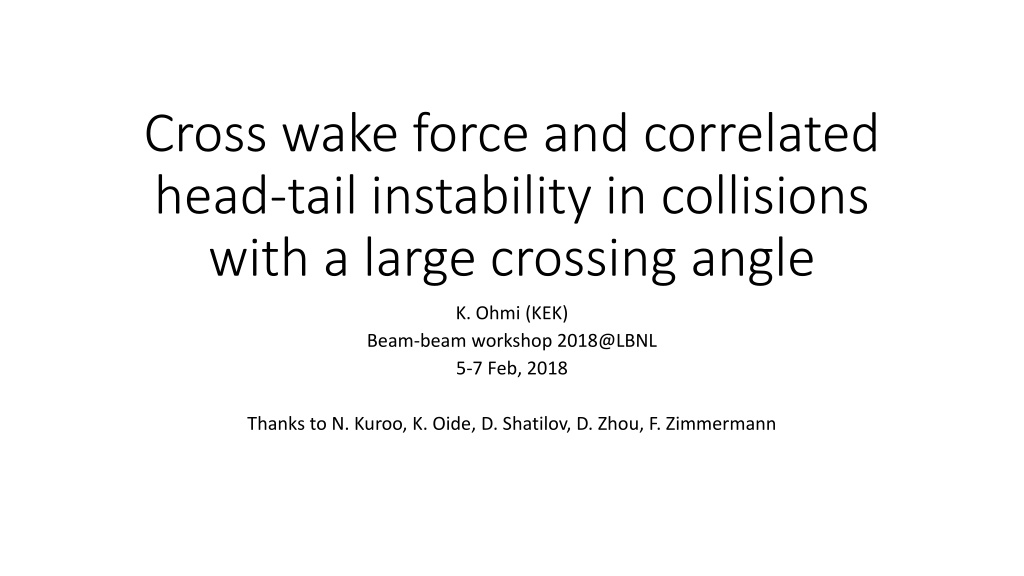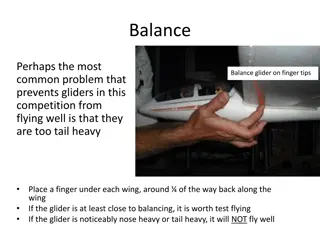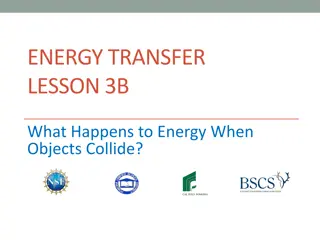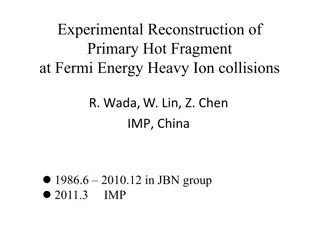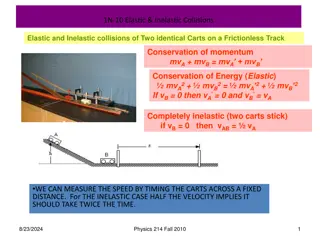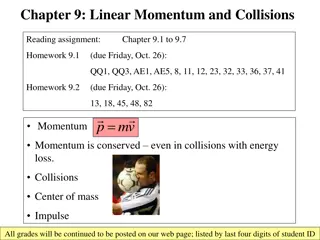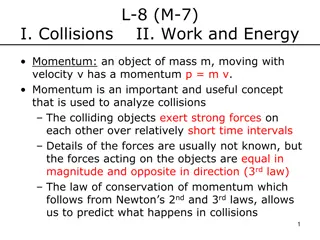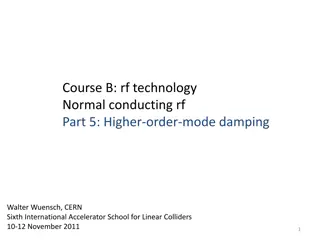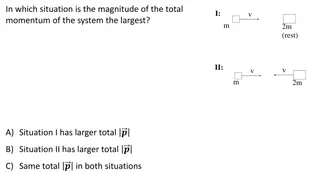Correlated Head-Tail Instability in Beam-Beam Collisions
The study discusses the impact of the cross wake force and correlated head-tail instability in collisions with a large crossing angle. It delves into the mechanism of beam-beam instability, cross wake force induction, mode coupling, and particle tracking simulations. Design parameters and instabilities observed in simulations of FCCee-Z and SuperKEKB are also highlighted, along with the derivation of the cross wake force and its impedance characteristics.
Download Presentation

Please find below an Image/Link to download the presentation.
The content on the website is provided AS IS for your information and personal use only. It may not be sold, licensed, or shared on other websites without obtaining consent from the author.If you encounter any issues during the download, it is possible that the publisher has removed the file from their server.
You are allowed to download the files provided on this website for personal or commercial use, subject to the condition that they are used lawfully. All files are the property of their respective owners.
The content on the website is provided AS IS for your information and personal use only. It may not be sold, licensed, or shared on other websites without obtaining consent from the author.
E N D
Presentation Transcript
Cross wake force and correlated head-tail instability in collisions with a large crossing angle K. Ohmi (KEK) Beam-beam workshop 2018@LBNL 5-7 Feb, 2018 Thanks to N. Kuroo, K. Oide, D. Shatilov, D. Zhou, F. Zimmermann
Contents 0. Introduction, Coherent beam-beam instability seen in strong-strong simulations. Mechanism of the beam-beam instability 1. Cross Wake force induced by beam-beam collisions with a large crossing angle. 2. Beam-beam ( / ) mode and reduction to single bunch wake force. 3. Particle tracking simulation using the cross wake force. 4. Mode coupling/head-tail instability caused by the cross wake force. 5. Mode coupling/head-tail instability caused by the cross wake force.
Parameters CERN-FCCee 2016 Pwinski angle : P= z c/ x 3
Coherent beam-beam Instability seen in strong-strong simulation FCCee-Z) Strong coherent beam-beam instability in head-tail mode has been seen in the design stage of FCCee-Z, W, H. Squeezing bx and increasing Piwinsi angle, the instability is suppressed and the design is being fixed.
Coherent beam-beam Instability seen in strong-strong simulation SuperKEKB) Design parameters of SuperKEKB was stable. We squeeze * step-by-step. Instability was seen in detuned * (8x,8x). We plan to study this instability in Phase II commissioning this year.
Mechanism of the instability- Cross wake force Usual wake force gives correlation between bunch head to tail. Head-tail instability is induced by synchrotron motion Cross wake field gives correlation of two colliding beam by convolution of each dipole moment. Cross wake force induced by the beam-beam interaction is localized at IP.
Derivation of the cross wake force Beam-beam force Difference for x Definition of the wake force Cross wake force For flat beam, neglect y, sy terms.
Cross wake force and its impedance Impedance is pure imaginary and symmetric for freq. Normalized Wake force is symmetric for z.
and mode for correlated head-tail motion mode: the dipole moment of two beams is identical mode: the dipole moment of two beams is opposite Cross wake force can be treated as ordinary wake force -/+ :
Ordinary mode coupling theory A. Chao, M is real and symmetric matrix. The eigenvalues are real. No instability. Couple to the same parity modes.
Diagonal component of M, tune shift Tune shift of mode is negative, while that of mode is positive.
Particle tracking using the cross wake force Wake force is localized at IP. Tracking algorithm 1. Revolution (synchro-betatron motion) 2. Wake force at IP A) Cross wake force B) single bunch wake force assuming mode. -/+ :
Tracking simulation results for two beams using the cross wake force SuperKEKB detuned b 8x8x . <xz> s of e+/e- beams are the same ( mode). The beam distributions showed a clear mode instability.
Tracking simulation results using single bunch wake force assuming mode FCCee-Z. The bunch population was scanned, where N0is the design value. The threshold is 0.1N0. Assuming mode, the beam is stable. Two beam simulation showed the same result.
Uniformly distributed wake Ring is divided into ndivparts with an equal synchrotron phase advance. Instability disappears at ndiv=8. It seems to be essential that the cross wake force is localized at IP.
Tune dependence of the instability in the simulation x=0.7, mode x=0.8, mode x=0.54, mode x=0.96, mode x=0.75, x=0.55, N=0.4N0, mode
What we know from the tracking simulation Clear mode instability was seen at x=0.54 for localized wake at IP. When the wake force distribute along the ring, the instability disappear. Localized wake force is essential for the instability. Simulations for single and cross wake force showed the same results. Distributions of x=0.54 and 0.96 are similar, though different mode . Distributions of x=0.7 and 0.8 are similar, though different mode . Basically, mode is dominant at x<0.75, while mode is dominant at x>0.75 mode instability can be induced at x=0.55. Complex mode is seen at x=0.75.
Mode coupling theory for localized single bunch wake force assuming mode Dipole amplitude in the longitudinal phase space at t-th turn. Density in the longitudinal phase space, independent of t. Dipole moment density .
One turn transformation Betatron oscillation for . Synchrotron oscillation Wake
Mode expansion using Laguerre-Fourier base Expand x and pxwith k l modes. Synchro-betatron motion, transformations for . Momentum kick due to the wake force Revolution matrix M0Mw. Solve eigenvalue problem for M0Mw. matrix size=[2(kmax+1)(2lmax+1)]2
Eigenvalue Eigenvalues appears as , where = is complex. The real part is tune, and the imaginary part is growth rate per turn. lmax=8, kmax=20 Eigenvector with the highest growth rate. l=2 mode ? =arctan(Im[?],Re[?])/2 Growth rate log|?| L=2 mode is induced.
Tune/growth for localized single bunch wake, x=0.54,0.96 When two modes merge or tune reach to 0.5, beams are unstable. lmax=8 kmax=20 = x l sat N= 0 < x=0.54> < x=0.96> l=0 s=0.018 l=-4 < mode> Mode coupling between l=0,-4 l=-1,-3 wit hthe same parity. (l=-2) arrives to 0.5, unstable at N=0.1N0. l=-1 l=-3 l=-2 < mode> No coupling between l = 2 and l = 3, though the tunes cross each other at N/N0 = 0.7. red plot mode blue plot mode =0.486 is wrapped to 0.514 =0.54 and 0.96 are symmetric tune for 0.75. Dominant mode are / , respectively, the same growth, symmetric behavior. Consistent with particle tracking 22
Tune/growth for localized single bunch wake, x=0.55 < mode> Wrapped l = 3 mode of mode is closed to 0.5. Tune shift is positive thus stable. mode instability is caused for l=-2 mode. The threshold for x = 0.55 is 4 times higher than that of x = 0.54. Similar growth rate at N0. l l=-1 l=-2 l=-3 < mode> Wrapped l = 3 mode of mode approach to 0.5, and becomes unstable. mode becomes unstable than s mode lower N. The particle tracking showed the mode instability at x=0.55. Instability is ( , ) ( / ) l, l 23
Mode coupling theory for localized cross wake force - two beam amplitude Momentum kick due to the cross wake force Mode expansion
Revolution matrix for the cross wake force Vector Betatron length=4(kmax+1)(2lmax+1) Synchrotron Wake force Revolution matrix, MWMsM Solve Eigenvalue problem
Result for the two beam model x=0.96 x=0.54 Eigenvector of the most unstable mode. For x=0.54, eigenvectors of e+/e- beam is identical, mode. For x=0.96, eigenvectors of e+/e- beam is opposite, mode. Perfect agreement with single bunch analysis assuming mode. x=0.54, mode x=0.96, mode
What we know from eigenvalue analysis using the cross wake force Single bunch wake force assuming mode. Tune shift of mode is negative, while mode is positive. When tune of a mode arrives at 0.5, or two modes with the same parity are merged, beam-beam system becomes unstable. Mode coupling is caused two modes between those w and w/o wrapping at 0.5. mode is dominant for x<0.75, while mode is dominant for x>0.75. The behavior is symmetric for x=0.75.
Eigen mode analysis for x=0.53 s(LER)=0.0247, s(HER)=0.0280 8x8x 4x8x x+ s(+) x-3 s(-) skb8x8xb
Eigen mode analysis for x=0.54 8x8x 4x8x skb8x8xc
Eigen mode analysis for x=0.55 8x8x 4x8x skb8x8xd
Strong-strong beam-beam simulation 8x8x, 1.44mAx1.04mA, x=0.53 skb2a
4x8x, 1mAx0.8mA , x=0.53 skb21b
Summary of the strong-strong simulation I=1.44mA x 1.04mA x 8x8x 4x8x L/L0, x/ x0 (L & H) osc. 0.58-0.66 6.5 4.5 L/L0, x/ x0 (L & H) osc. 0.75-1.0 3.0-7.5 2.2-6.2 0.53 a 0.535 g 0.70-0.95 2.5-6.2 1.4-4.0 1.04 1.2 1.0 0.54 d 0.75-0.95 2.5-6.0 1.4-4.0 1.05 2.1 1.1 0.545 f 0.83 7.2 1.2 no osc. 0.94 5.2 1.7 0.55 e 0.75-0.77 8.6 3.5 Horizontal emittance growth does not contribute luminosity drop in collision with a large crossing angle, when yis large. Crab waist on in the simulation. CW-off may be serious for the horizontal emittance growth.
Conclusions Strong-strong beam-beam simulation showed a strong coherent beam-beam instability in head-tail mode at the collisions wit ha large crossing angle. To explain the instability, the cross wake force is introduced, particle tracking and eigenmode analysis were performed. The particle tracking gave guiding toward a complete theory based on the eigenmode analysis. It is essential that the wake force is localized at IP. Eigenmode analysis represents characteristics of this instability. Experiments in SuperKEKB is done soon.
